Quantitatively determining the astringency of a foodstuff is very difficult to do but can be extremely useful when identifying behavioural differences between formulations and likely customer perception. For example, it is an extremely powerful technique when considering how switching an animal-derived product for a plant-derived product can affect mouthfeel, or how the interactions between the product and either saliva or another product change. This mini-study outlines the impact of changing between animal-derived and plant-based milk upon the astringency of tea.
Contact us to arrange a lab tour and discuss rheological techniques with our experts
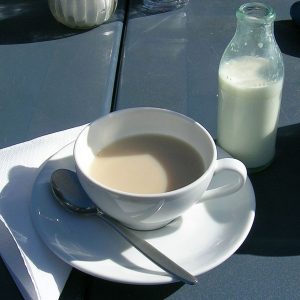
Astringency and mouthfeel
Astringency is a property of a foodstuff that can lead to a puckering or drying sensation in the mouth or throat. Astringency can cause the mouth to feel rough, raw or sandpapery and can be experienced when drinking tea or red wines, or when eating some unripe fruits e.g., bananas. Within teas, astringency is attributed to the presence of tannins and catechins, both a type of polyphenol, that are present in the tea leaves. It is the interaction of these polyphenols with proteins in saliva that causes the astringent feeling. Astringency of teas can be altered by the following methods:
- Drinking different varieties. For example, oolongs are considered less astringent than black or green tea.
- Heating or roasting the leaves. Roasting the leaves for longer reduces the polyphenol content and therefore astringency.
- Adding milk. The milk binds to tannins in the tea, which lowers the astringency.
Tribology and rheology are effective benchmarks for comparing beverages and elucidating their properties. Tribological profiling entails quantifying the coefficient of friction across a range of conditions and can be used to help predict the mouthfeel of different products, whereas rheology can reveal differences in a fluid’s behaviour, for example in relation to flow or structure.
As noted earlier, the feeling of astringency is caused when proteins in saliva interact with components of a foodstuff, for example tannins or other polyphenols. When this interaction happens, it can cause precipitation of salivary proteins. This precipitation can be linked to the coefficient of friction, where a lower coefficient of friction indicates little (or no) precipitation, and a higher coefficient of friction can indicate significant precipitation. This change in coefficient of friction can be quantified using tribology.
Saliva is a complex mixture that contains mucins, amylases, defensins, cystatins, histatins, proline-rich proteins, statherin, lactoperoxidase, lysozyme, lactoferrin, and immunoglobulins. Porcine gastric mucin is an accepted surrogate for salivary mucin and allows for investigation into the interactions between foodstuffs and mucin.
Tribology of soft surfaces
Tribology is the study of the friction, lubrication and wear of interacting surfaces. Biotribology, or soft tribology, is the specific study of compliant, biological surfaces such as the eyelid and cornea, tongue and palate, lips, mucous membranes or interacting skin surfaces. Unlike rheology testing, where the sample under test is held in a defined gap between surfaces moving relative to each other, tribology testing entails bringing those surfaces into contact under a defined load and sliding one against the other, measuring the frictional drag over a range of sliding speeds. The surfaces and any applied lubricating liquid form the test sample.

Tribology results are often displayed as a Stribeck curve, shown below:
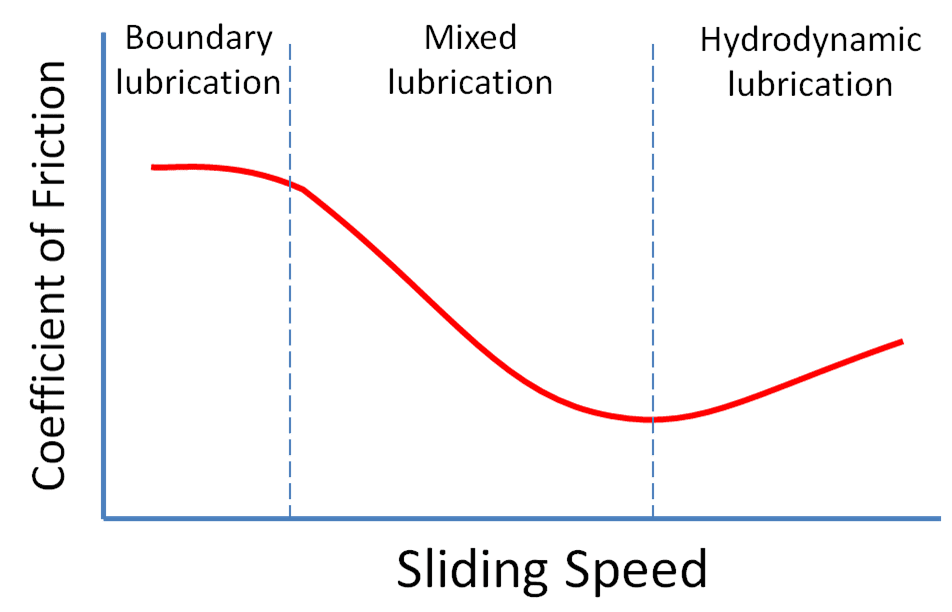
The idealised Stribeck curve comprises of three regions: boundary lubrication, mixed boundary-hydrodynamic lubrication and hydrodynamic lubrication. At low speeds the surfaces are in close contact and any surface features on the substrate and upper surface are interlocking. Under these conditions lubrication is low, therefore friction is high.
As the sliding speed is increased the lubricant between the upper and lower surfaces creates hydrodynamic lift, resulting in increasing separation of the surfaces and decreasing frictional drag. Eventually, as sliding speed is increased, a complete separation of the surfaces occurs and the final part of the Stribeck curve is reached. From the key features of the Stribeck curve we can derive metrics that clearly differentiate between materials of differing lubricating qualities.
While direct interpretation of in-vitro measurements of sensory properties is difficult and fraught with complexity, it is still possible to gather useful information to guide formulation design choices. Using the Stribeck curve as a ‘tribological fingerprint’ of a sample, a multi-variate approach coupled with rheology (such as that seen in our benchmark similarity scoring method) could help inform a formulator of what combination of physical properties could be utilised to target for a set of sensory properties.
Comparing plant-based and animal-derived milk behaviour in tea

In this study we set out to ascertain how plant-based and animal-derived milks varied in terms of their reduction of the astringency of tea. To achieve this, three experiments were conducted:
- Measurement of the coefficient of friction of the milks on their own.
- Comparison between the coefficient of friction of tea and tea with added milk.
- Measurement of interaction between the teas with added milk and mucin to determine comparative astringency.
Tea was prepared by taking one tea bag, adding 200 mL boiling water and allowing the tea to brew for 5 minutes. To a 20 mL aliquot of tea was then added 2 mL of milk. The milks compared were semi-skimmed cow milk, almond milk and oat milk.
Studying the interaction between mucin and teas made with milk from plant-based or dairy sources will provide insight into the effect of the milk source upon the astringency of tea. For example, an increase in coefficient of friction could indicate precipitation of salivary proteins and therefore indicate astringent behaviour.
COF comparison between milks
The first experiment was to compare the coefficient of friction between the milks tested to ascertain if there were any differences before addition of the tea, Figure 1. Considering the coefficient of friction for each milk sample, at low sliding speeds (below 10 mm/s) semi-skimmed milk had the largest coefficient of friction and oat milk had the smallest i.e. at slower sliding speeds the semi-skimmed milk was the least lubricating and oat milk the most. At higher sliding speeds, the oat milk and semi-skimmed milk tended towards the same lubricity and almond milk became the least lubricating, relatively.
All the milks tested were less lubricating than the pure tea solution at lower sliding speeds, but as the sliding speed increased the lubricity of the milks and tea tended towards each other.
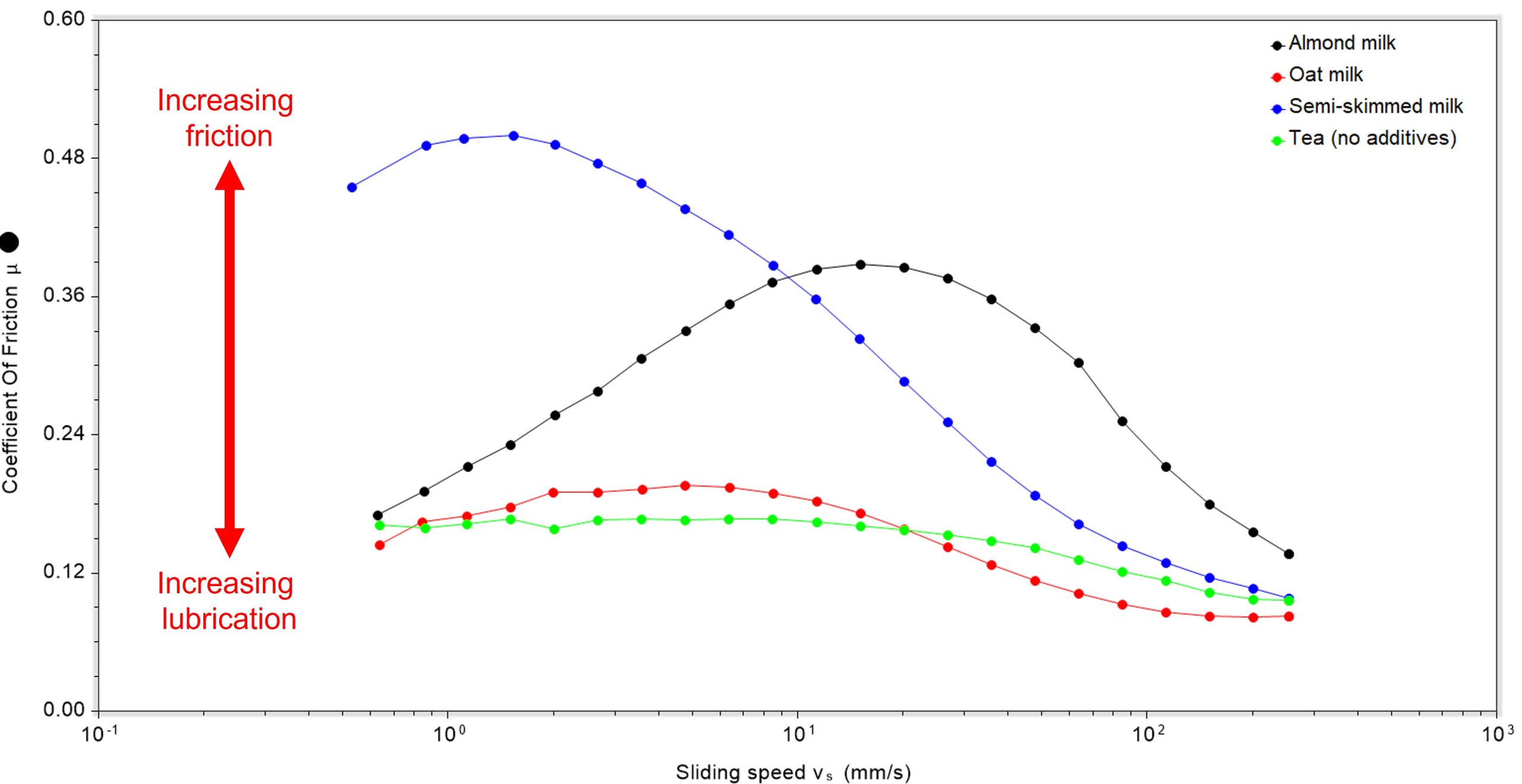
COF for tea mixed with milk
The next experiment was to compare the coefficient of friction, or lubricity, of tea when mixed with milks, Figure 2. Considering these data, at lower sliding speeds (below 10 mm/s) tea with semi-skimmed milk had the highest coefficient of friction and tea with oat milk the lowest. However, at higher sliding speeds the coefficient of friction for all samples was fairly similar and there were only small differences. In all cases, the addition of milk decreased the lubricity of the tea.
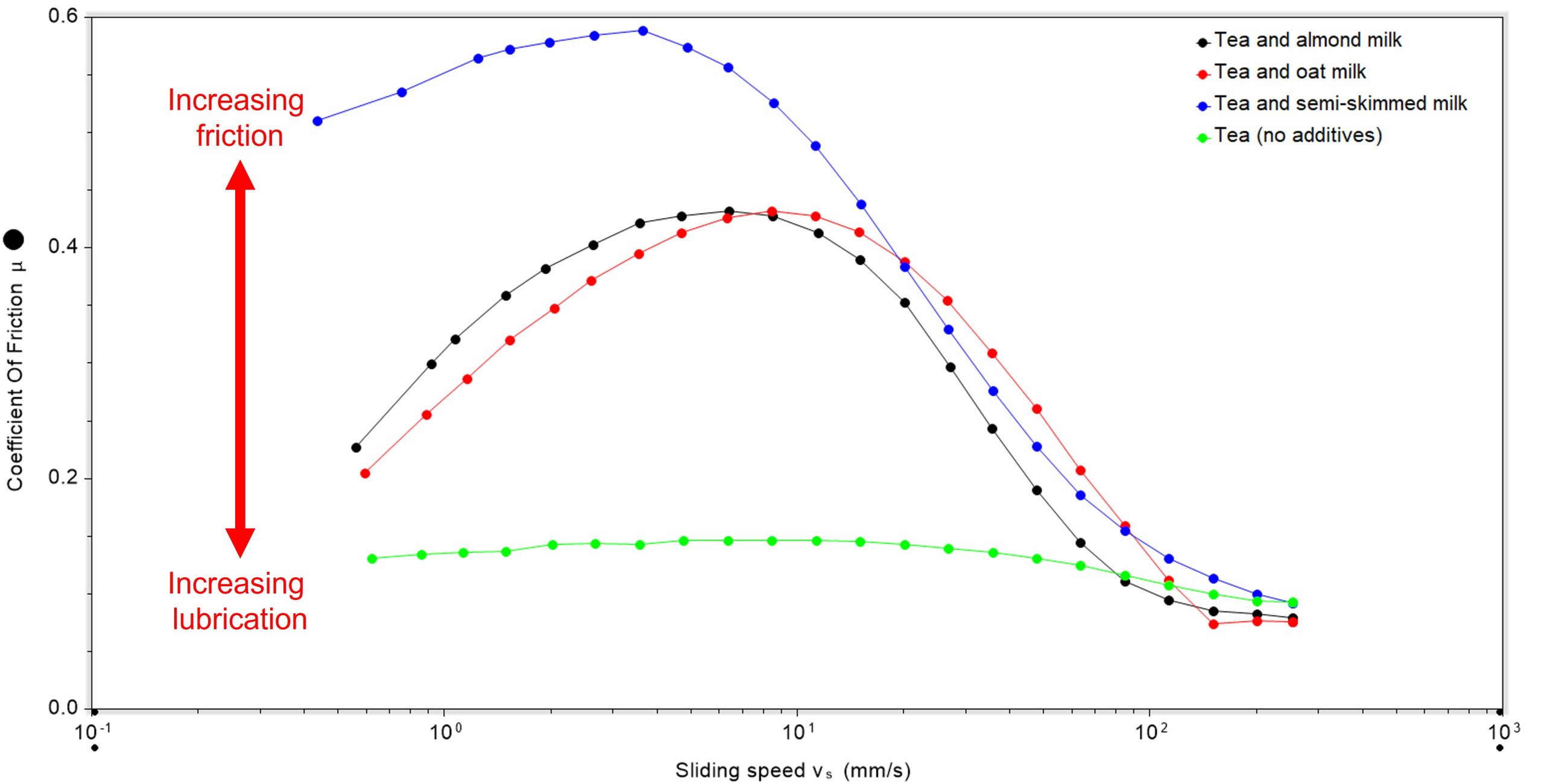
Comparing the coefficient of friction between the pure milks and tea mixed with milk, it was seen that addition of milk to the tea significantly changed behaviour, Figure 3. In all cases, when milk was added to the tea the coefficient of friction increased. The most marked difference was with oat milk, where addition of oat milk to the tea significantly increased the coefficient of friction, particularly at medium sliding speeds.
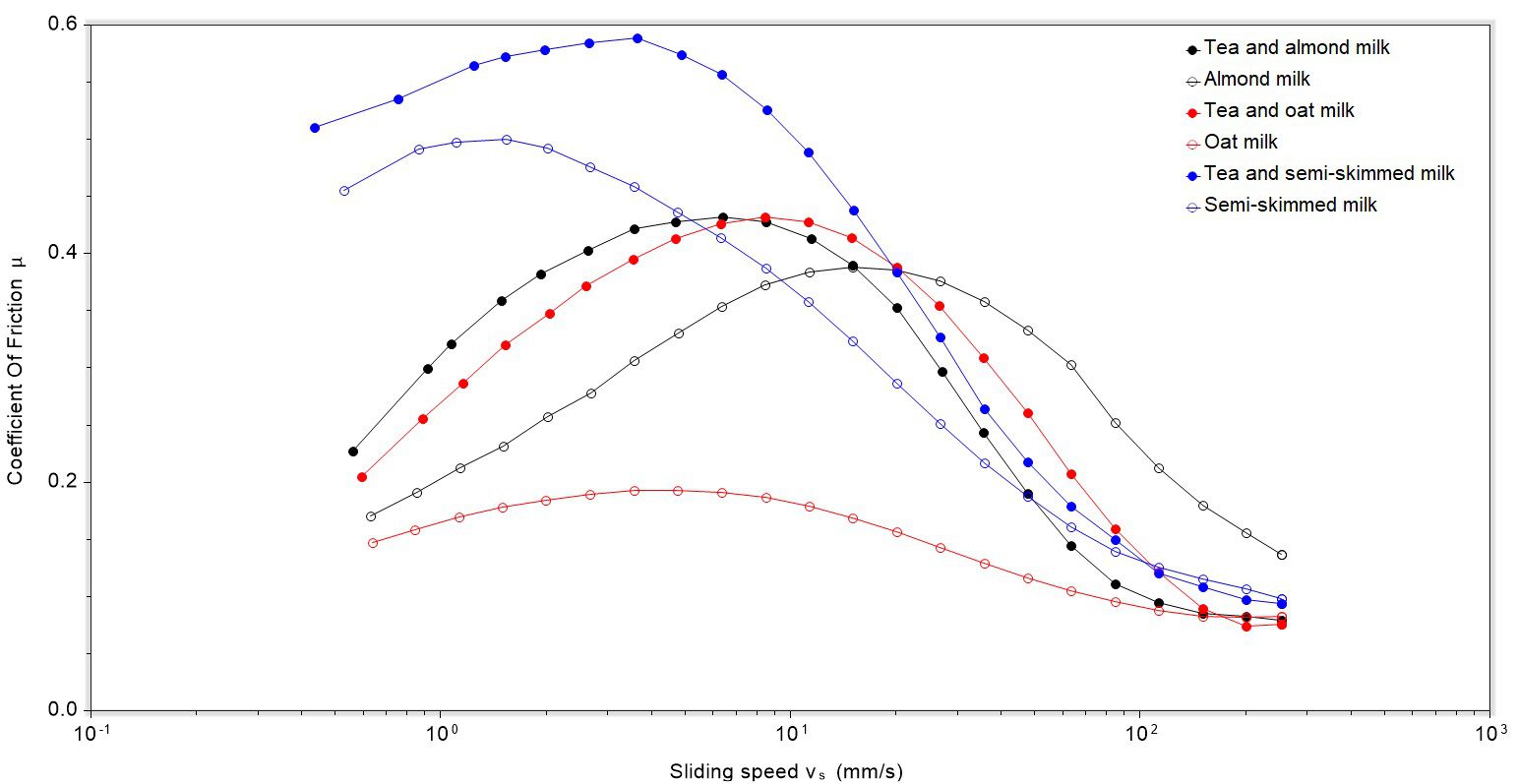
Determining astringency
The final experiment considered the impact of mucin upon the pure tea sample and the mixture of tea with milk i.e. how the tea would interact with saliva in the mouth, Figure 4. A higher coefficient of friction, which means decreased lubrication or lubricity, can suggest precipitation of salivary proteins and therefore increased astringency.
An aqueous solution of porcine mucin was prepared and adjusted to pH 7, to reflect the pH in the oral cavity. The mucin was then mixed with the tea solutions in a 1:1 ratio.
Tea with mucin had the highest coefficient of friction across all sliding speeds (the opposite of the trend shown in Figure 1) showing that there was likely an interaction between mucin and the tea that affected the lubricity. Comparatively, the interaction between mucin and tea with added milk led to a lower coefficient of friction and therefore an increase in lubricity across all sliding speeds. At lower sliding speeds (below 10 mm/s), tea with semi-skimmed milk had the highest lubricity (smallest coefficient of friction) and tea with almond milk the lowest (largest coefficient of friction). As the sliding speed increased, the tea with semi-skimmed milk became the least lubricating and tea diluted oat milk the most, although the differences identified were small.
In the case of astringency, the fact that pure tea had the highest coefficient of friction showed that it is most likely to have led to precipitation of salivary proteins, which is known to occur when polyphenols, or other known astringents, interact with saliva. In the samples where milk was added to the tea, the coefficient of friction was smaller, suggesting that the milk might have an impact and prevent salivary protein precipitation. This therefore means that addition of milk to tea does decrease astringency, but in this case, there were no large differences between whether the milk was plant-based or animal-derived.
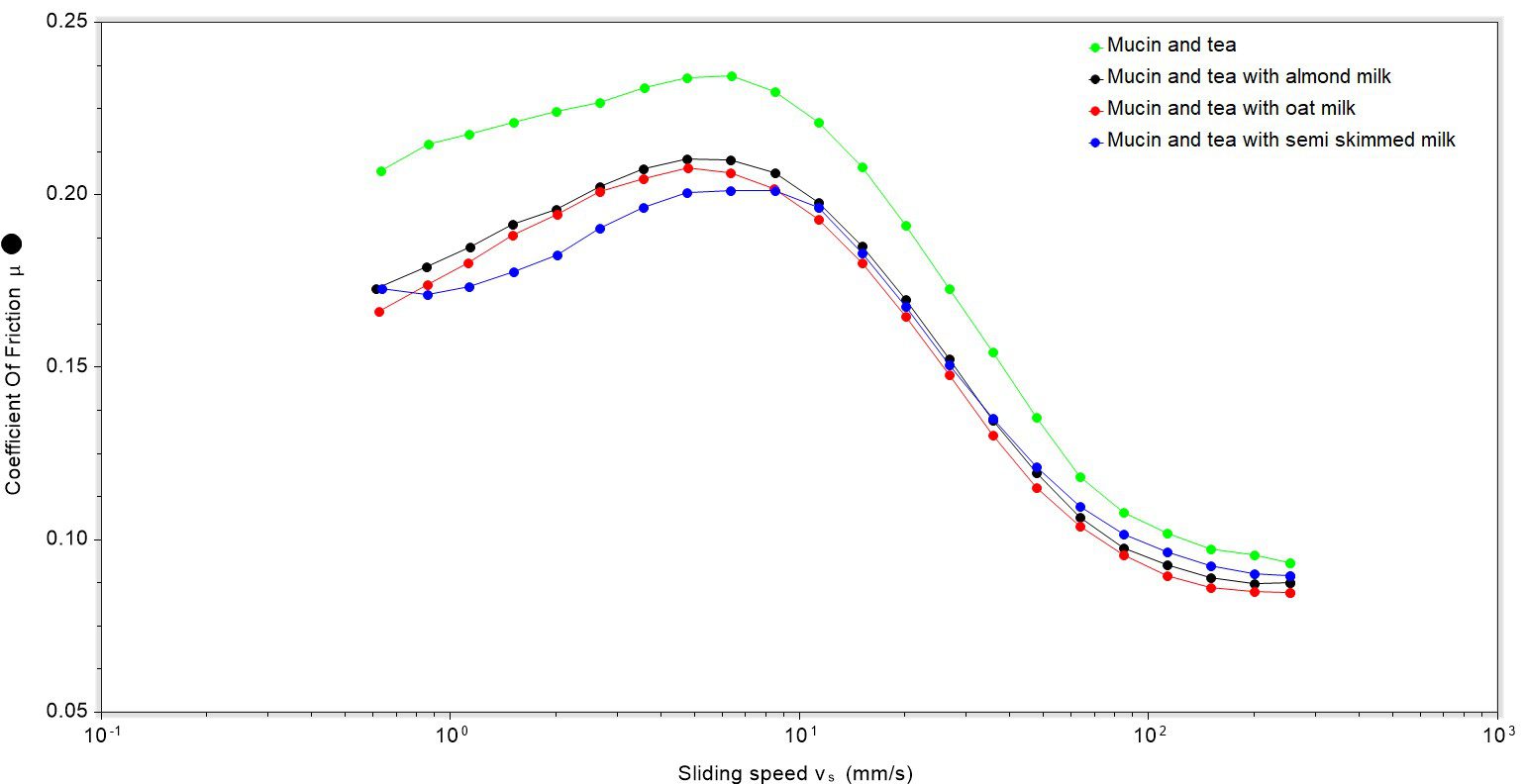
Summary
In summary, investigating how the coefficient of friction of teas with the addition of different milks, revealed interesting behaviours. In particular, the behaviour observed between the samples and mucin has given insight to how astringency of tea is affected by the addition of milk. In this case, both plant-based and animal-derived milks decrease the astringency to the same extent.
To the food scientist or formulator, the coefficient of friction can provide a valuable link, and importantly quantify, the likely astringency of a product upon consumption.
For further information about this testing, and other testing regimes that we offer, please get in touch!
